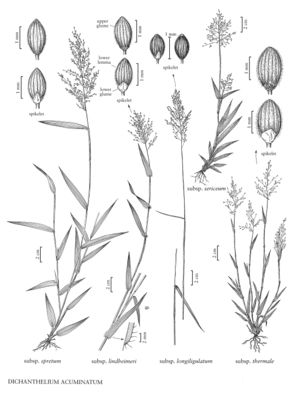Difference between revisions of "Dichanthelium acuminatum subsp. spretum"
FNA>Volume Importer |
FNA>Volume Importer |
||
| Line 7: | Line 7: | ||
|name=Panicum spretum | |name=Panicum spretum | ||
|authority=unknown | |authority=unknown | ||
| − | }}{{Treatment/ID/Synonym | + | }} {{Treatment/ID/Synonym |
|name=Panicum acuminatum var. densiflorum | |name=Panicum acuminatum var. densiflorum | ||
|authority=unknown | |authority=unknown | ||
| Line 21: | Line 21: | ||
-->{{Treatment/Body | -->{{Treatment/Body | ||
| − | |discussion=<p>Dichanthelium acuminatum subsp. spretum grows in wet to moist, sandy or peaty soil, pine savannahs, and bogs. It is not a common taxon, but is most frequent on the coastal plain and around the Great Lakes. It is very similar to the more common, southern subsp. longiligulatum. It also resembles D. dichotomum in size and overall habit.</p> | + | |discussion=<p><i>Dichanthelium acuminatum </i>subsp.<i> spretum</i> grows in wet to moist, sandy or peaty soil, pine savannahs, and bogs. It is not a common taxon, but is most frequent on the coastal plain and around the Great Lakes. It is very similar to the more common, southern <i></i>subsp.<i> longiligulatum</i>. It also resembles <i>D. dichotomum</i> in size and overall habit.</p> |
|tables= | |tables= | ||
|references= | |references= | ||
| Line 41: | Line 41: | ||
|publication year= | |publication year= | ||
|special status= | |special status= | ||
| − | |source xml=https://jpend@bitbucket.org/aafc-mbb/fna-data-curation.git/src/ | + | |source xml=https://jpend@bitbucket.org/aafc-mbb/fna-data-curation.git/src/8f726806613d60c220dc4493de13607dd3150896/coarse_grained_fna_xml/V25/V25_1166.xml |
|subfamily=Poaceae subfam. Panicoideae | |subfamily=Poaceae subfam. Panicoideae | ||
|tribe=Poaceae tribe Paniceae | |tribe=Poaceae tribe Paniceae | ||
Revision as of 16:28, 18 September 2019
Culms usually glabrous; nodes often swollen, glabrous; fall phase often with reclining culms, ultimately with fascicles of branches with greatly reduced blades and secondary panicles. Cauline sheaths usually glabrous; blades 3-9 mm wide, usually firm, ascending to reflexed, puberulent or glabrous abaxially, glabrous adaxially, with sparse papillose-based cilia at the bases. Primary panicles 4-12 cm long, 1/4 - 1/2 as wide as long, usually narrow, congested. Spikelets 1.3-1.9 mm, ascending to appressed, usually ellipsoid, usually puberulent (rarely glabrous).
Discussion
Dichanthelium acuminatum subsp. spretum grows in wet to moist, sandy or peaty soil, pine savannahs, and bogs. It is not a common taxon, but is most frequent on the coastal plain and around the Great Lakes. It is very similar to the more common, southern subsp. longiligulatum. It also resembles D. dichotomum in size and overall habit.
Selected References
None.
